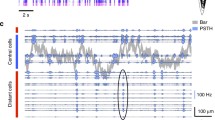Abstract
A theory of early visual information processing proposed by Marr and co-workers suggests that simple cortical cells may be involved in the detection of zero crossing in the retinal output. We have tested this theory by using pairs of adjacent edges (staircases stimuli) and recording from edge-specific simple cells in cat striate cortex. The zero crossing hypothesis gives rise for such stimuli to non-obvious predictions that were generally confirmed by the experiment.
Similar content being viewed by others
References
Békésy G von (1968) Mach- and Herring-type lateral inhibition in vision. Vision Res 8:1483–1499
Cornsweet TN (1970) Visual perception. Academic Press, New York
Enroth-Cugell C, Robson JG (1966) The contrast sensitivity of retinal ganglion cells of the cat. J. Physiol (Lond) 187:517–522
Enroth-Cugell C, Robson JG, Schweitzer-Tong DE, Watson AB (1983) Spatio-Temporal interactions in cat retinal ganglion cells showing linear spatial summation. J Physiol 347:279–307
Grimson WEL, Hildreth EL (1985) Comments on digital step edges from zero crossings of second directional derivatives. IEEE Trans PAMI 7 (1):121–129
Kusaka H (1982) Suppression characteristics of the Mach phenomenon in staircase patterns emphasized with edge transitions. Proc. SID 23 (2):95–102
Marr D, Hildreth E (1980) Theory of edge detection. Proc R Soc Lond B 207:187–217
Marr D, Poggio T (1979) A computational theory of human stereo vision. Proc R Soc Lond B 204:301–328
Marr D, Ullman S (1981) Directional selectivity and its use in early visual processing. Proc Soc Lond B 211:151–180
Ratliff S (1984) Why Mach bands are not seen at the edges of a step. Vision Res 24:163–165
Richter J, Ullman S (1982) A model for the spatio-temporal organization of X- and Y-type ganglion cells in the primate. Biol. Cybern 43:127–145
Rodieck RW (1965) Quantitative analysis of cat retinal ganglion cell response to visual stimuli. Vison Res 5:583–601
Schiller PH, Finlay BL, Volman SE (1976) Quantitative studies of singlecell properties in monkey striate cortex. I. Spatio temporal organization of receptive fields. J Neurophysiol 39:1288–1319
Shapely RM, Tolhurst DJ (1973) Edge detectors in human vision. J Physiol Lond 229:165–183
Tolhurst DJ (1972) On the possible existence of edge detector neurons in the human visual system. Vision Res 12:797–804
Witkin A (1983) Scale-space filtering. Proc. IJCAI, Karlsruhe, pp 1019–1021
Yuille AL, Poggio T (1983) Scaling theorems for zero crossings. MIT A.I. Memo 722
Author information
Authors and Affiliations
Rights and permissions
About this article
Cite this article
Richter, J., Ullman, S. Non-linearities in cortical simple cells and the possible detection of zero crossings. Biol. Cybern. 53, 195–202 (1986). https://doi.org/10.1007/BF00342887
Received:
Issue Date:
DOI: https://doi.org/10.1007/BF00342887




